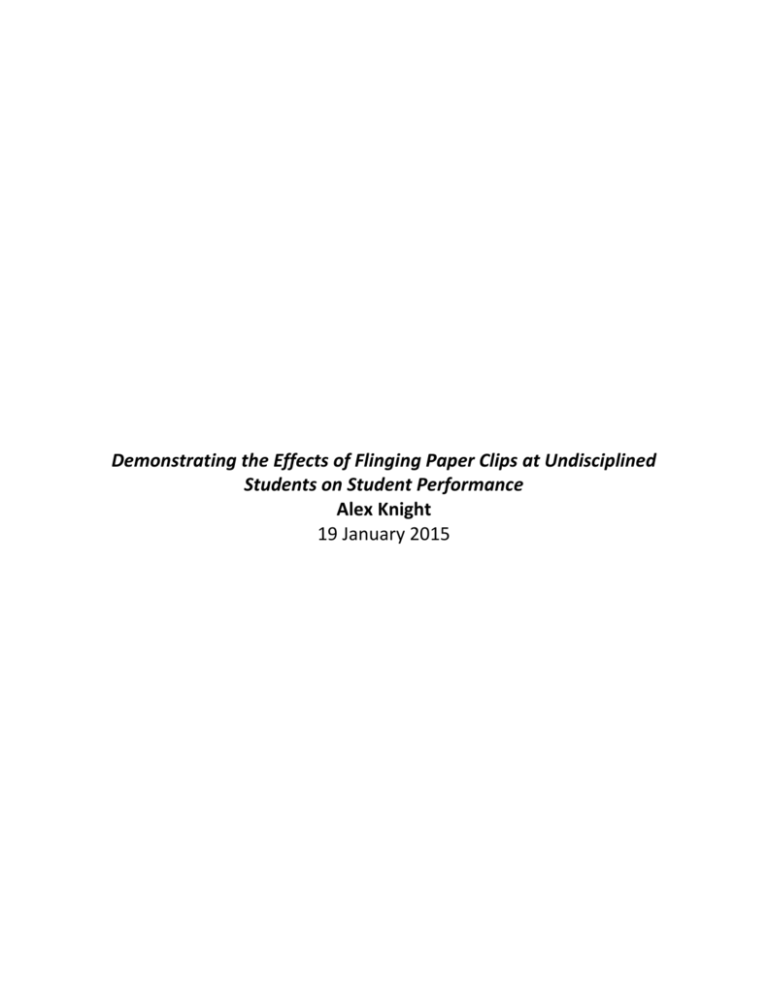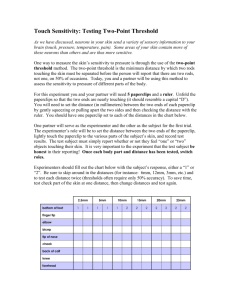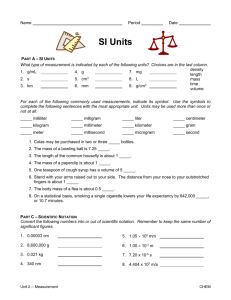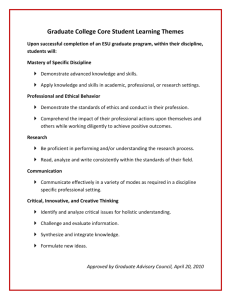Formatting Exemplar
advertisement

Demonstrating the Effects of Flinging Paper Clips at Undisciplined Students on Student Performance Alex Knight 19 January 2015 Abstract [Here you will record an overall look at your experiment(s), research and project as a whole. This section will seem very redundant, but you need to briefly describe the background—in 2-3 sentences—briefly describe what you are testing and the experiment(s) you performed and what things you measured and tested—in 3-5 more sentences, be brief—briefly describe what your results were and whether or not it agreed with our original thoughts or hypothesis or hypotheses—2-3 sentences—and briefly present an unbiased claim based on your data—1, maybe 2 sentences. The abstract serves to present a summary of your project’s information in a one-paragraph, one-page format, so keep in mind length of your writing and do not use too much detail. Also, use ONLY passive voice.] e.g. The world pressures students to perform better and better each generation. Teachers are paramount to student success. While students may behave inappropriately to deride a teacher’s efforts to guide students to success, teachers must find ways to overcome the rigors of poor efforts and motivation, no matter what the cause. In this investigation, experiments were performed to determine if there is a link between student performance and one type of crude behavior-control method—flinging paperclips at students per their efforts and/or abilities to follow teacher-given instructions. Several types of student behaviors were targeted for examination: 1) Students were reprimanded with a paperclip for sleeping in order to awaken them from their unproductive slumber; [do not use such adjectives as “unproductive”—I only seek to apply humor in this fictitious report.] 2) Students were reprimanded for not paying directing eye-level attention to the teacher; 3) Students were reprimanded for directing eyelevel attention from their work during individual work sessions. Students were tested at regular intervals over information covered in a typical Biology class. Of three class periods of College Preparatory Biology, only one of the classes was under the paperclip punishment per each of the 7 testable units. The class being reprimanded as such as rotated after each unit in order that each class was under the reprimand for 2 units. Students overall test scores were compared from one unit exam to the next. Student test scores were compared to similar students from other class periods not under the same paperclip discipline. Students were deemed similar by socio-economic background, race, and 8th grade CRCT reading level. Additionally, students responded to a survey about the effect felt as a result of the paperclip scrutiny. Students seemed to perform better against their own prior performance and with regard to other, similar students. These results demonstrate that there may be a correlation between paperclip-flinging discipline tactics and student performance. Teachers may need to begin employing a paperclip-flinging behavior management discipline system in their own classroom in order to curb the under-performance of America’s school-aged youth and future leaders. ii Table of Contents I. II. III. IV. V. VI. VII. VIII. Question, Terms, and Hypotheses ..................................................... Background ......................................................................................... Materials............................................................................................. Procedures.......................................................................................... Results, Data Tables and Figures ........................................................ Discussion ........................................................................................... Conclusion .......................................................................................... Works Cited ........................................................................................ 1 1 3 4 5 7 8 9 i Knight I. Question, Terms, and Hypotheses [List all pertinent questions after introducing them like with a subheading called, “Questions Investigated,” ENTER, terms and definitions, which should also be introduced with a subheading, ENTER, at least one hypothesis or hypotheses, which remember just means educated guess about what you think will happen and should also be introduced with a subheading.] II. Background [Include all of the 3-9 paragraphs of background information you have been working on gathering and writing since the week before Thanksgiving Break.] 1 Knight 2 III. Materials [List all materials you used in order to conduct the experiment and gather results. List or bulleted list format is perfect.] IV. Procedures [Include here a numbered procedural list of steps in order to follow so that someone else could come after you, following your steps and complete the experiments as instructed, and potentially yield similar results because your procedure was so clear and concise.] Knight V. Results, Data Tables and Figures [Include here any data tables or figures or pictures or graphs pertinent to displaying your data. This only should include the neatest and most effective demonstration of your data and should include all data you used to make judgments and thoughts based on the project.] VI. Discussion [Include here how you interpret the data to mean something. Here, you do not need to make bold claims or agree or disagree with your hypothesis. This is simply a verbal restatement of the data that serves to make numbers and data into to words and sentences. This section is so that the reader may simply be explained what the results say in word form. It almost serves as a handicap acknowledgement as if the reader cannot interpret tables] 3 Knight 4 VII. Conclusion [Include here bold claims based on the data. Here is where you will determine whether your results agree or disagree with your hypothesis or hypotheses. This need only take 4-9 sentences if you are concise and effective in your writing. This section is not for you to say, “Yippee! I was right! I am a genius!” Your conclusions should sound intelligent—e.g. the results showing students test averages were higher while under the paperclip discipline may suggest the paperclip discipline is an effective classroom management tool. Further, the increased test scores between similar students while under the paperclip discipline versus not under the discipline suggests even more that the paperclip discipline is effective. One can conclude that there may be a correlation between performance and paperclip discipline, or direct, minor, physical discipline.] Knight 5 Works Cited [Include here all sources from which you got information that you did not write with your own hand, or in your own words. See The Internet for assistance in this section. You should have at least 2-5 sources, at least with Science Buddies and some background source.] Page Numbers and Headers and Table of Contents Format







